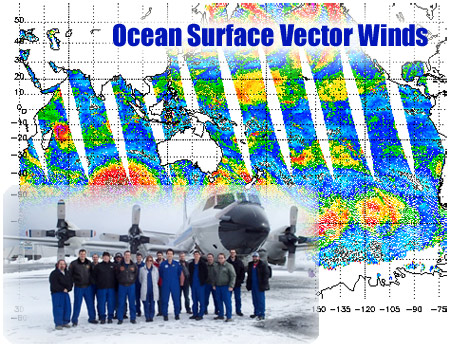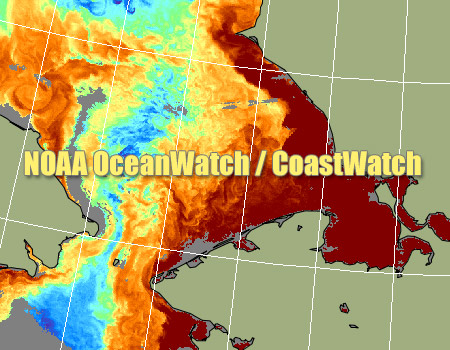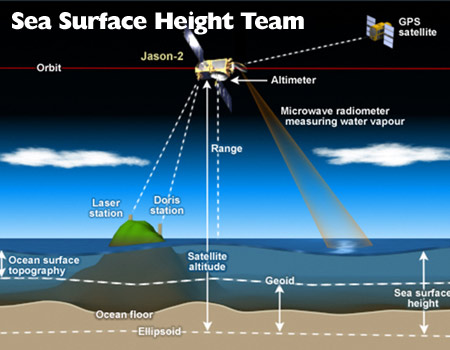
Satellite Oceanography and Climatology Division (SOCD)
The Coral Reef
Watch mission is to utilize remote sensing and in situ tools for
near-real-time and long term monitoring, modeling and reporting of physical
environmental conditions of coral reef ecosystems. Our satellite data provide
current reef environmental conditions, especially the monitoring of sea surface
temperature at global scales, to quickly identify areas at risk for coral
bleaching, providing researchers and stakeholders with tools to understand
and better manage the complex interactions leading to these events.

The Ocean
Color Research Team at NOAA/NESDIS/STAR seeks to develop improved ocean
color products from the current and future ocean color satellite sensors including
the Sea-viewing Wide Field-of-view Sensor (SeaWiFS), the Moderate Resolution Imaging
Spectroradiometer (MODIS) on the both Terra and Aqua, and the Visible Infrared
Imaging Radiometer Suite (VIIRS) on the Suomi National Polar-orbiting Partnership
(SNPP) and the Joint Polar Satellite System (JPSS), as well as various satellite
sensors from other countries, e.g., the Medium Resolution Imaging Spectrometer (MERIS),
Geostationary Ocean Color Imager (GOCI), Ocean Land Colour Instrument (OLCI),
Second-Generation Global Imager (SGLI), etc.

The primary objective of the Ocean Surface Winds Team (OSWT)
is to provide science support for remotely-sensed ocean surface wind products through
product development, validation, improvement and user education and outreach. Its
objective is to improve utilization of these data within NOAA and to provide guidance
and support in planning for current and future missions. The OSWT works closely with
operational forecasters in the NWS and other parts of NOAA, and thus, much of its
research, development and validation is in support of the near real-time product stream.
In support of these activities OSWT operates several near real-time satellite product
processing systems and supports the Ocean Winds flight experiment program with the
NOAA P-3 aircraft.

NOAA
OceanWatch was established in 1987 in response to two major environmental
events: a Harmful Algal Bloom occurred off the coast of North Carolina, and more than
700 bottlenose dolphins died along the mid-Atlantic coast. These events prompted the
government to explore additional avenues for monitoring coastal waters, including
satellite data. CoastWatch has expanded from POES/AVHRR SST data for the East Coast
to providing environmental satellite data covering all U.S. coastal waters. Today,
sea surface temperature maps support weather prediction and inform commercial and
recreational activities. Biologists utilize ocean color data, derived chlorophyll-a
and total suspended matter/ turbidity products to predict HABs; and maritime operators
use ocean surface vector winds for navigation.

The Sea Ice Science Team is composed of
participants from the STAR/SOCD Laboratory for Satellite Altimetry, the U.S. National
Ice Center, and external collaborators from academia. In addition to remote sensing
research on sea ice characterization and applications development, the team is
interested in other cryospheric topics including snow over sea ice and land, lake
ice, icebergs, and ocean-ice shelf interaction. The team also contributes leadership
and expertise to the international Arctic and Antarctic buoy programs and provides
advice to NOAA, Navy, the U.S. Coast Guard and other agencies on global cryospheric
issues with particular focus on the development and implementation of strategies for
the Arctic region. Sites include: National
Ice Center, MASIE, and LSA Sea Ice Site.

Research activities of Sea Surface Height Science
Team include monitoring and understanding sea
level rise, creating near
real time altimetry products, improving altimetric
bathymetry, and developing new techniques for Delay-Doppler/SAR processing. The team
analyzes/calibrates data from Jason-2 and Jason-3 radar altimeter missions, which will
continue the 20 year global sea level record. Near real-time sea surface height, wave
height, and wind speed are used to determining ocean currents, monitoring sea level,
and assimilating into models to improve forecasts of El Niño and hurricane
intensity. Other activities aim to develop the most accurate and complete global
bathymetry dataset from altimeter and ship measurements.

The goal of the Sea Surface Roughness Science
Team is to research, develop, demonstrate, and operationally implement
oceanographic products derived from satellite synthetic aperture radar (SAR) data.
These products include: SAR-derived winds and wind climatology; hurricane and storm
morphology, swell wave parameters; oil spill maps; vessel and marine debris detection;
oil platform, coastline, and bathymetry change detection; ice masking and classification;
atmospheric boundary layer phenomena; and internal waves. More information at: STAR SOCD Water Surface Conditions / Synthetic Aperture Radar (SAR) Products.

The Sea-Surface Salinity Science Team,
led by Dr. Eric Bayler is an open forum that encourages development of a satellite
SSS community of practice and includes cross-NOAA representation, as well as
participation from NASA, including the Aquarius mission's leadership, and Navy.
Within NOAA, the SSS Science Team maintains a repository of the current version of
all Level-2 data from NASA's Aquarius mission and ESA's Soil Moisture - Ocean Salinity
(SMOS) mission, as well as select Level-3/4 gridded products. This data is available
for NOAA research, development, and transition to operations. NOAA's developmental
satellite SSS Level-3/4 gridded products are available via the NOAA
CoastWatch/OceanWatch website.

The Sea Surface Temperature Team is responsible
for the development, science maintenance and validation of various Level 2, 3 and 4 SST
products from current and future polar and geostationary satellites. We work with our
partners in the NOAA Office of Satellite Products and Operations (OSPO), to generate
high-quality SST products and satisfy needs of NOAA and external users, in the areas of
climate monitoring, seasonal forecasting, operational weather and ocean forecasting,
military and defense operations, validating of ocean and atmospheric models, ecosystem
assessment, tourism, and fisheries. We also participate in the international Group for
High Resolution SST.
Hover to pause slides The Satellite Oceanography and Climatology Division (SOCD) provides the research and development of remote sensing data on the world's oceans, and calibrates instruments, verifies the data, and creates products to meet the needs of users for satellite data and other information on the oceans. The three branches of the Division (Ocean Sensors, Ocean Physics, and Marine Ecosystems), and the Science Teams do research in observing sea surface temperature, sea surface winds, sea surface height, ocean color, sea ice, and sea surface roughness. The Teams then transfer the results of their research into operational practice. The Division transforms satellite data into high-quality, state-of-the-art products and information on the oceans. Examples include using ocean color to locate and identify harmful algal blooms ('red tides'); observing the roughness of the sea-surface for locating sea ice and its extent; measuring ocean surface winds in support of weather forecasts; and analyzing sea surface temperature and sea surface height for hurricane predictions. Ocean data and products are available from the Division's NOAA CoastWatch, NOAA OceanWatch, and NOAA Coral Reef Watch. The Division's activities and goals are cross-cutting, supporting all the NOAA Mission Goals. |
|